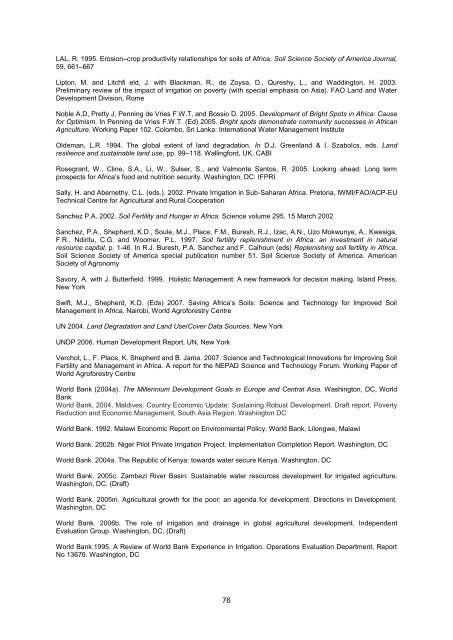The CAADP Pillar I Framework
The CAADP Pillar I Framework
The CAADP Pillar I Framework
- No tags were found...
Create successful ePaper yourself
Turn your PDF publications into a flip-book with our unique Google optimized e-Paper software.
LAL, R. 1995. Erosion–crop productivity relationships for soils of Africa. Soil Science Society of America Journal,59, 661–667Lipton, M. and Litchfi eld, J. with Blackman, R., de Zoysa, D., Qureshy, L., and Waddington, H. 2003.Preliminary review of the impact of irrigation on poverty (with special emphasis on Asia). FAO Land and WaterDevelopment Division, RomeNoble A.D, Pretty J, Penning de Vries F.W.T, and Bossio D. 2005. Development of Bright Spots in Africa: Causefor Optimism. In Penning de Vries F.W.T. (Ed) 2005. Bright spots demonstrate community successes in AfricanAgriculture. Working Paper 102. Colombo, Sri Lanka: International Water Management InstituteOldeman, L.R. 1994. <strong>The</strong> global extent of land degradation. In D.J. Greenland & I. Szabolcs, eds. Landresilience and sustainable land use, pp. 99–118. Wallingford, UK, CABIRosegrant, W., Cline, S.A., Li, W., Sulser, S., and Valmonte Santos, R. 2005. Looking ahead: Long termprospects for Africa‘s food and nutrition security. Washington, DC: IFPRISally, H. and Abernethy, C.L. (eds.). 2002. Private Irrigation in Sub-Saharan Africa. Pretoria, IWMI/FAO/ACP-EUTechnical Centre for Agricultural and Rural CooperationSanchez P.A. 2002. Soil Fertility and Hunger in Africa. Science volume 295. 15 March 2002Sanchez, P.A., Shepherd, K.D., Soule, M.J., Place, F.M., Buresh, R.J., Izac, A.N., Uzo Mokwunye, A., Kwesiga,F.R., Ndiritu, C.G. and Woomer, P.L. 1997. Soil fertility replenishment in Africa: an investment in naturalresource capital. p. 1-46. In R.J. Buresh, P.A. Sanchez and F. Calhoun (eds) Replenishing soil fertility in Africa.Soil Science Society of America special publication number 51. Soil Science Society of America. AmericanSociety of AgronomySavory, A. with J. Butterfield. 1999. Holistic Management: A new framework for decision making. Island Press,New YorkSwift, M.J., Shepherd, K.D. (Eds) 2007. Saving Africa‘s Soils: Science and Technology for Improved SoilManagement in Africa. Nairobi, World Agroforestry CentreUN 2004. Land Degradation and Land Use/Cover Data Sources. New YorkUNDP 2006. Human Development Report. UN, New YorkVerchot, L., F. Place, K. Shepherd and B. Jama. 2007. Science and Technological Innovations for Improving SoilFertility and Management in Africa. A report for the NEPAD Science and Technology Forum. Working Paper ofWorld Agroforestry CentreWorld Bank (2004a). <strong>The</strong> Millennium Development Goals in Europe and Central Asia. Washington, DC, WorldBankWorld Bank, 2004. Maldives: Country Economic Update: Sustaining Robust Development. Draft report. PovertyReduction and Economic Management, South Asia Region. Washington DCWorld Bank. 1992. Malawi Economic Report on Environmental Policy. World Bank, Lilongwe, MalawiWorld Bank. 2002b. Niger Pilot Private Irrigation Project. Implementation Completion Report. Washington, DCWorld Bank. 2004a. <strong>The</strong> Republic of Kenya: towards water secure Kenya. Washington, DCWorld Bank. 2005c. Zambezi River Basin: Sustainable water resources development for irrigated agriculture.Washington, DC. (Draft)World Bank. 2005m. Agricultural growth for the poor: an agenda for development. Directions in Development.Washington, DCWorld Bank. 2006b. <strong>The</strong> role of irrigation and drainage in global agricultural development. IndependentEvaluation Group. Washington, DC. (Draft)World Bank.1995. A Review of World Bank Experience in Irrigation. Operations Evaluation Department, ReportNo 13676. Washington, DC76
















